We included HMH Into Math Grade 8 Answer Key PDF Module 1 Lesson 1 Investigate Transformations to make students experts in learning maths.
HMH Into Math Grade 8 Module 1 Lesson 1 Answer Key Investigate Transformations
I Can describe what happens to the sides and angles of a figure when It is transformed.
Spark Your Learning
Rachel is tiling a rectangular floor using triangles. Draw a triangle and cut it out. Move the triangle in different ways, and trace those shapes to draw a rectangular pattern using triangular tiles. Experiment with different shapes of triangles and different ways of moving the triangle to tile the whole floor with no gaps or overlapping tiles.

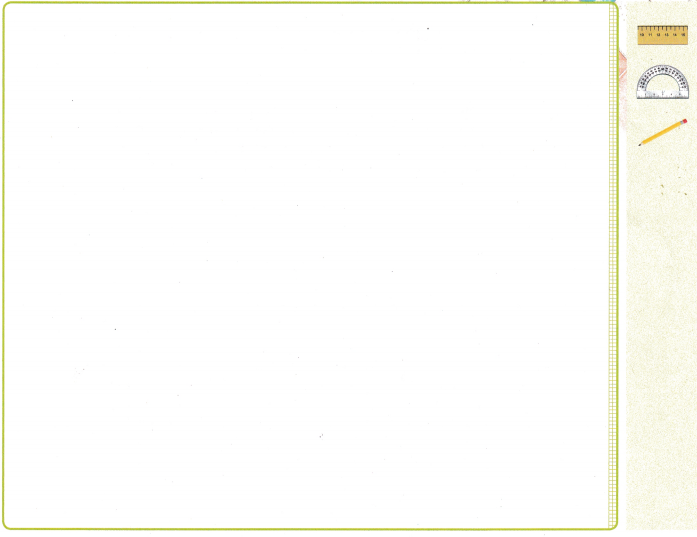
Answer:
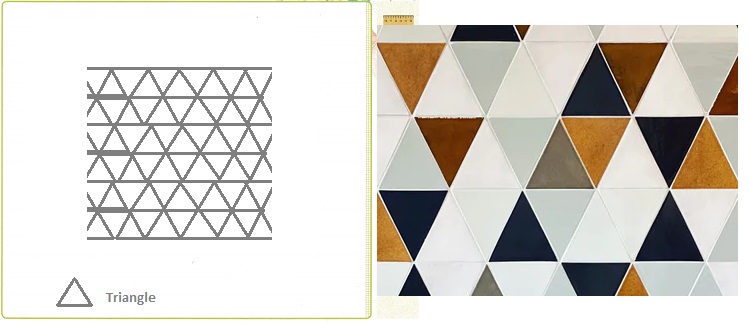
Explanation:
Triangle is slid and marked on the rectangular plane,
all the marked places are joined with different shapes of triangles and,
different ways of moving the triangle to tile,
the whole floor with no gaps or overlapping tiles.
Turn and Talk Describe multiple ways you could move the original triangle to tile the floor.
Answer:
Answer may vary.
Explanation:
Triangle is slid and marked on the rectangular plane,
all the marked places are joined with different shapes of triangles and,
different ways of moving the triangle to tile,
the whole floor with no gaps or overlapping tiles.
Build Understanding
Connect to Vocabulary
A transformation is a change in the position of a figure.
1. On graph paper, draw a quadrilateral that has exactly one pair of parallel sides. Remember, parallel sides are sides that would not intersect even if extended indefinitely. Cut out the shape and trace it in the center of the box.

Answer:
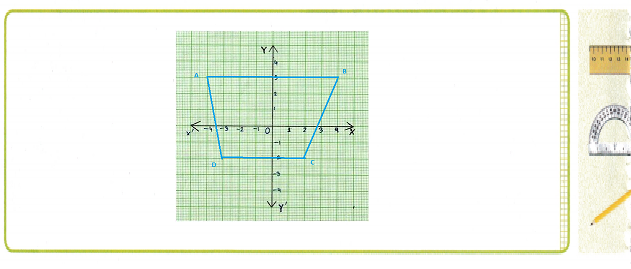
Explanation:
With the help of a ruler draw a quadrilateral on graph paper,
that has exactly one pair of parallel sides.
Remember, parallel sides are sides that would not intersect even if extended indefinitely.
Cut out the shape and trace it in the center of the box as shown above..
A. Slide the quadrilateral to a new location in the box and trace it.
Describe the direction and length you slid the shape.
Answer:
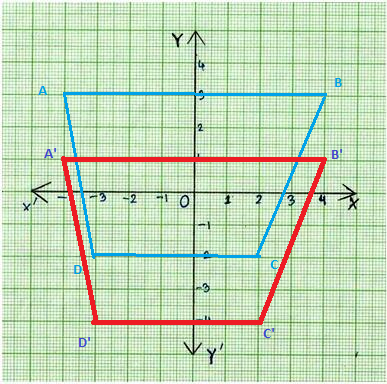
Explanation:
The quadrilateral with red color A’B’C’D’ shifted down to a new location,
as shown in the box and trace above the down ward direction and,
2 units length you slid the shape.
B. Use a ruler to measure the sides of each quadrilateral. Use a protractor to measure the angles of the original shape and the new shape. What has happened to the lengths of the sides, the measures of the angles, and the relationship between the parallel sides of the two shapes?
Answer:
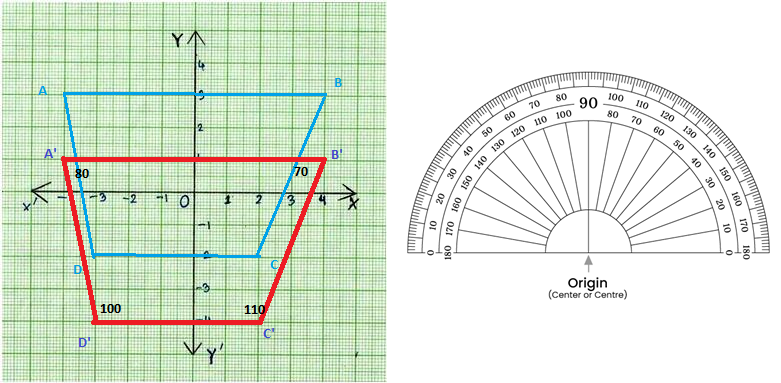
Explanation:
A ruler is used to measure the sides of each quadrilateral,
AB = 8 cm
BC = 5.4 cm
DC = 5 cm
AD = 5.1 cm
C. When you slid the shape, did anything change besides its position?
Answer:
No change.
Explanation:
No change occur in the shape of the original image,
the lengths and the the angles between the sides of the quadrilateral.
When we slid the shape translation transformation takes place.
A translation is a type of transformation that takes each point in a figure,
and slides it the same distance in the same direction.
D. Draw a horizontal line near, but outside, your second quadrilateral. Flip the second quadrilateral in Part A over the horizontal line and trace it in the box as your third shape. Measure the lengths of the sides and the angles of both quadrilaterals. Have the relationships between the sides and angles of the original shape changed or stayed the same compared to the flipped shape?
Answer:
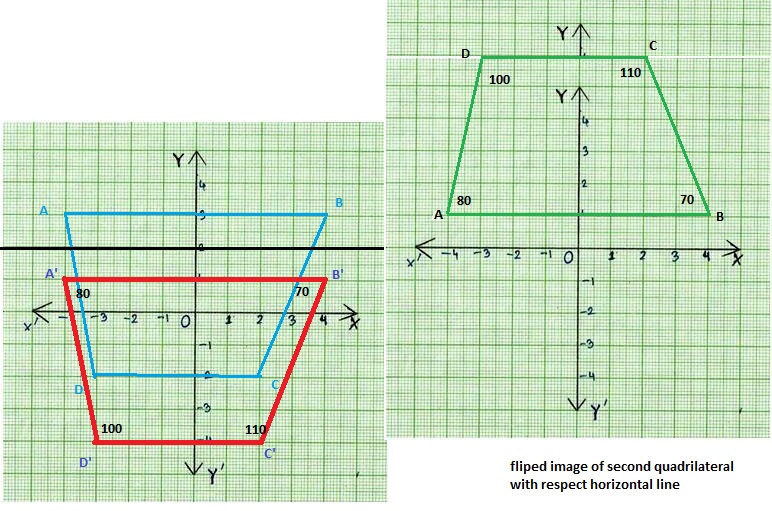
Explanation:
The relationships between the sides and angles of the original shapes,
not changed or stayed the same lengths and angles as shown in the above figure.
When we flip the image there is no change in the shape,
as flip is the reflection the original image.
Turn and Talk Describe a way to move the third quadrilateral back to the original location of the first quadrilateral.
Answer:
To move the third quadrilateral back to the original location of the first quadrilateral,
we get the reflection of the same origin or image.
Explanation:
As shown in the question number 1, bit number D,
both Green and Blue quadrilaterals are same with side lengths and angles.
Both the quadrilaterals are reflected to each other.
2. On graph paper, draw a polygon that has at least six sides and one pair of parallel sides. Cut out the shape and trace it in the center of the box.
A. Place the tip of your pencil on the center of the shape and turn the shape. Trace the shape in its new location.
Answer:

Explanation:
A polygon that has at least six sides and one pair of parallel sides drawn on a graph paper.
The shape in the center of the box is traced as shown above.
B. How do the sides and angles of the original polygon compare to the polygon you drew after turning the original?
Answer:
The sides and angles of the original polygon are same.
Change takes place in the position of the shape as 90 degrees.
Explanation:
The sides and angles of the original polygon ABCDEF fig(a),
compare to the polygon drew after turning the original A’B’C’D’E’F’ as shown in fig(b),
are same in size and lengths of the polygon and the angles between the sides are same.
Only the change in the fig(b) as shown above is the picture to turned to 90 degrees.
C. Trace the shape again. Then, place the tip of your pencil on one corner of the shape and turn it. Trace the shape in its new location.
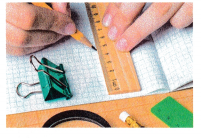
Answer:

Explanation:
The trace of polygon is shifted to a new location as shown in the above figure..
D. Draw an X on one angle of the original shape and on the same angle of the turned shape. Describe how the angle has been moved.
Answer:
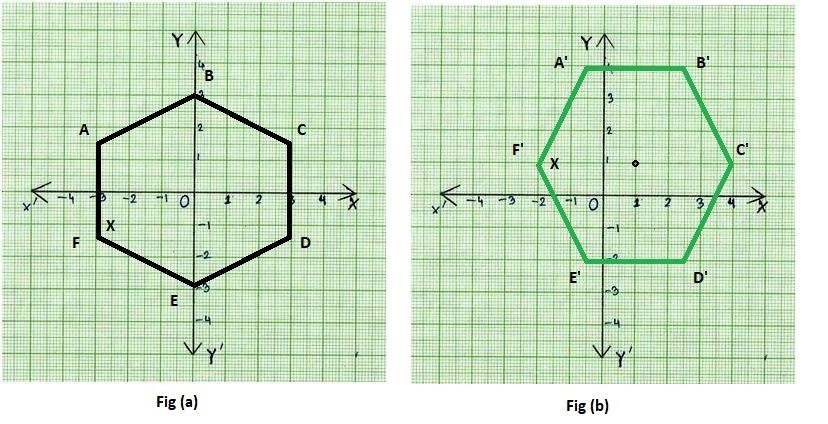
Explanation:
As shown in the above figures the angle X is marked on the graph at angle F,
and is at negative y – axis is shifted to positive y- axis after turning the graph.
E. Based on these two examples, what do you think stays the same and what changes when a shape is turned?
Answer:
Based on these two examples the side lengths and the angle between the sides will not change.
Only the co-ordinates of the graph will change, as shown in fib(a) and fig(b) on the graph paper.
Turn and Talk Two students use two different transformations on the same shape. One student slides it up. The other student flips it. What is true about the side lengths and angle measures of both transformed shapes?
Answer:
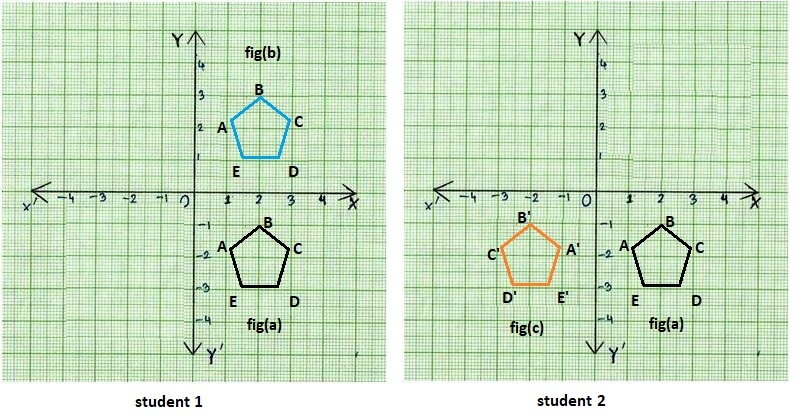
Explanation:
There is no change in the side lengths and angle measures of both transformed shapes.
A translation is a type of transformation that takes each point in a figure,
and slides it the same distance in the same direction.
A reflection is also known as a flip which is a mirror image of the shape.
An image will reflect through a line, known as the line of reflection.
A figure is said to reflect the other figure,
then every point in a figure is equidistant from each corresponding point in another figure.
3. Dakota has a mirror in the shape of a trapezoid. She started by hanging the mirror in one location. Then she decided to hang the mirror in a different location.
A. Complete the drawing of the mirror in its new location.
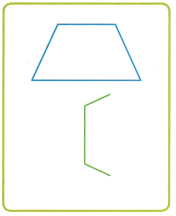
Answer:
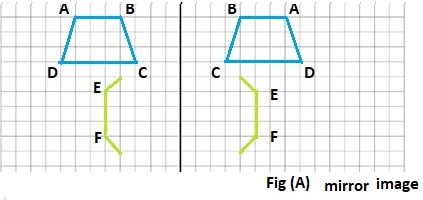
B. How could Dakota move the mirror from the first location to the second location?
Answer:
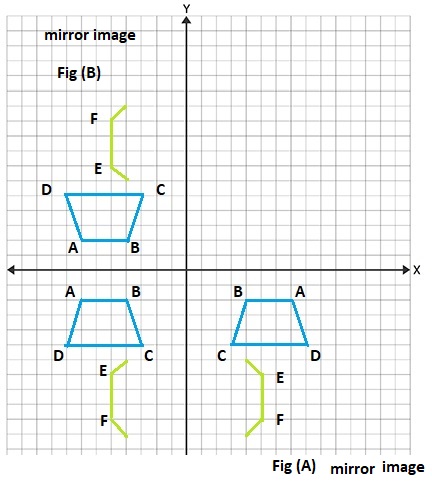
C. How have the parallel sides of the mirror changed?
Answer:
No change in the side lengths and angle measures of the original reflected images in Fig (A) and Fig (B).
D. Describe how the side lengths and angle measures were affected when Dakota moved the mirror. How do you know?
Answer:
Orientation of the figure is changed to the right faced to the left side faced.
No change in the side lengths and angle measures of the original image or figure.
Explanation:
A reflection is also known as a flip which is a mirror image of the shape.
An image will reflect through a line, known as the line of reflection.
A figure is said to reflect the other figure,
then every point in a figure is equidistant from each corresponding point in another figure.
Check Understanding
Question 1.
Darby hung a kite on the wall. Then she slid the kite higher on the wall to a better position. What is true about the size and shape of her kite? Explain what happened to the side lengths and angle measures after she made the move.
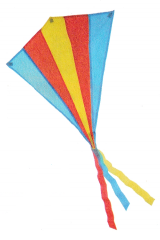
Answer:
There is change in length of the sides and angles.
Explanation:
If she slid the kite higher on the wall to a better position,
the size and shape of her kite will never change.
If the kite is translated horizontally, vertically, or both with a factor of k,
after translation can be represented in the general form as f(x) = f(x + k) + C.
The length of the sides will change if the shape of the kite is changed,
then the angle of the kite is also changed.
In fig(a) side lengths increased with a enlargement scale factor of k and,
in the fig(b) the angle between the sides changed.
The side lengths and angle measures after she made the move will look like as shown below.
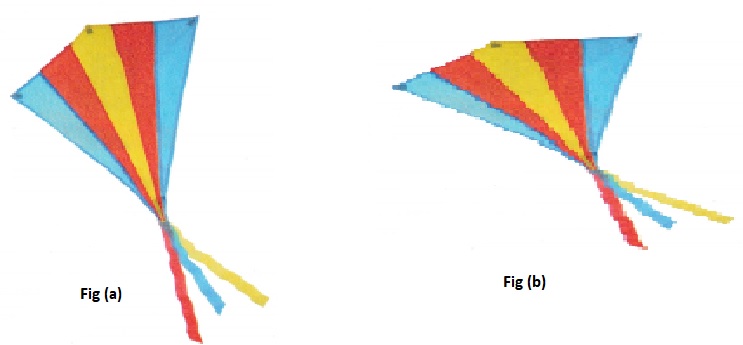
Question 2.
Marlon cuts a label in the shape of a capital letter V. He turns the label one-quarter turn clockwise to place it on a package. Which way is the open part of the V facing after the rotation?
Answer:
Right side turned, the open part of the V facing after the rotation.

Explanation:
Rotation means the circular movement of an object around a center.
It is possible to rotate different shapes by an angle around the center point.
Question 3.
Rachel tells Jonah that she can turn a square, but he won’t be able to tell that it was turned after she is finished. How can she do this?
Answer:
Square has same length of sides and cuboid.
Explanation:
If the cuboid is turned right the shape of the cuboid is same shape.
That is the reason behind the Rachel that he ‘won’t be able to tell that it was turned after she is finished’.
On Your Own
Question 4.
Tarik is working on a photo album and moved a photo as shown. What transformation did he use?
Answer:
Transformation of Rotation,

Explanation:
Rotation means the circular movement of an object around a center.
It is possible to rotate different shapes by an angle around the center point.
The photo is rotated right with same origin,
To rotate the figure 90 degrees clockwise about a point,
every point(x, y) will rotate to (y, -x).
Let’s understand the rotation of 90 degrees clockwise about a point visually.
So, each point has to be rotated and new coordinates have to be found and shifted to 3 points up.

Use the information to answer Problems 5-6.
Ryan lays a pentagonal pattern on a piece of fabric.
Question 5.
If Ryan slides the pattern two inches to the right, what happens to the measure of the angles of the pentagon?
Answer:
They stay the same measure.
Explanation:
When we slide the pentagon the pattern 2 inches to the right translation occurred.
A translation is a type of transformation that takes each point in a figure,
and slides it the same distance in the same direction.
So, they stay the same measure.
Question 6.
Ryan decides to rotate the pattern one-fourth turn clockwise. What happens to the lengths of the sides of the pattern?
Answer:
No change in the lengths and angles of the pentagonal pattern on a piece of fabric.
Explanation:
When we rotation an object around a center one-fourth turn to clockwise,
No change in the lengths and angles of the pentagonal pattern on a piece of fabric.
Question 7.
Reason Beckie cuts out a piece of paper in the shape of a trapezoid with only one pair of parallel sides. The parallel sides are 2 inches apart. Then she flips the shape over. What is the distance between the parallel sides of the flipped shape? Explain how you know.
Answer:
2 inches.
Explanation:
The distance between the parallel sides of the flipped shape is 2 inches.
Trapezoid has a pair of parallel sides.
After bisecting also there is no change in the distance.
As it shows the transformation of reflection.
A reflection is known as a flip which is a mirror image of the shape.
A figure is said to reflect the other figure,
then every point in a figure is equidistant from each corresponding point in another figure.
Question 8.
Reason Is Figure B a transformation of Figure A? Why or why not?
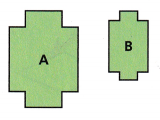
______________
Answer:
Yes,
Explanation:
Transformation of dilation is done with the scale factor = k.
RSF Reduction Scale Factor \(\frac{1}{k}\)
A dilation should either stretch or shrink the original shape.
This transformation is expressed by the term “scale factor.”
If a dilation creates a larger image, then it is known as enlargement.
If a dilation creates a smaller image, then it is known as reduction.
Question 9.
Reason Is Figure Y a transformation of Figure X? Why or why not?
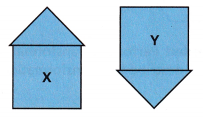
Answer:
Yes,
Explanation:
A rotation is a transformation that turns a figure about a point.
It is possible to rotate different shapes by an angle around the center point.
Hence, transformation of rotation is done in the above figures.
Question 10.
Bailey has a sheet of plywood with four right angles. She saws off one of the angles and turns the plywood one-half turn clockwise. How many right angles are there on the plywood now?

Answer:
Three right angles
Explanation:
If it she turns the plywood one-half turn clockwise, three right angles are there on the plywood.
As she saws off one of the angles , out of four right angled plywood sheet,
consists of three right angles only.
Use the information to answer Problems 11—12.
Margot draws a shape with one pair of parallel lines that are four centimeters apart. She then flips the shape across a horizontal line.
Question 11.
How many pairs of parallel lines are on the flipped shape?
Answer:
1 pair of parallel lines.
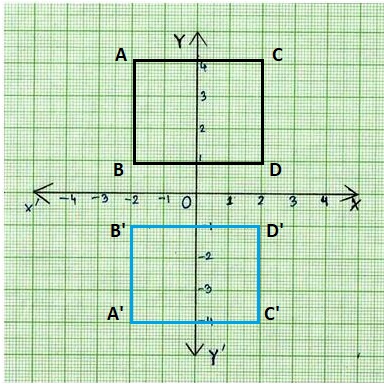
Explanation:
After drawing a shape with one pair of parallel lines that are of four centimeters,
if Margot flips the shape across a horizontal line there is no change in parallel lines.
As it shows the transformation of reflection.
A reflection is known as a flip which is a mirror image of the shape.
A figure is said to reflect the other figure,
then every point in a figure is equidistant from each corresponding point in another figure.
Question 12.
How far apart are the parallel lines on the flipped shape? How do you know?
Answer:
No change.
Explanation:
As they are 4 cm apart in the original figure and flipped figure as shown above.
A figure is said to reflect the other figure,
then every point in a figure is equidistant from each corresponding point in another figure.
Question 13.
Complete each transformation of the given figure.

Answer:

Explanation:
A transformation is a process that manipulates a polygon on a plane or coordinate system.
As shown above reflection of transformation takes place to form a simple polygon.
Question 14.
Complete the drawing of the parallelogram after a slide to the right.

Answer:

Explanation:
A reflection is a transformation that flips a figure across a line.
A reflection is known as a flip which is a mirror image of the shape.
An image will reflect through a line, known as the line of reflection.
A figure is said to reflect the other figure,
then every point in a figure is equidistant from each corresponding point in another figure.
Question 15.
Open Ended Perform a transformation on the shape. Draw the result and describe the transformation you performed.

Answer:
Transformation of Reflection,
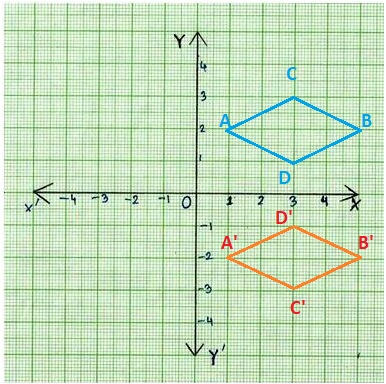
Explanation:
A reflection is known as a flip which is a mirror image of the shape.
An image will reflect through a line, known as the line of reflection.
A figure is said to reflect the other figure,
then every point in a figure is equidistant from each corresponding point in another figure.
I’m in a Learning Mindset!
Did I have confidence in my answer to Problem 15? What specific evidence do
Answer:
Yes, I have confidence.
Explanation:
A transformation is a process that manipulates a polygon on a plane or coordinate system.
A reflection is known as a flip which is a mirror image of the shape.
An image will reflect through a line, known as the line of reflection.
A figure is said to reflect the other figure,
then every point in a figure is equidistant from each corresponding point in another figure.
Lesson 1.1 More Practice/Homework
Question 1.
Social Studies Nautical flags are used by ships for signaling. Flipping a flag vertically can be a sign of distress. The flag representing the number 7 is shown. Where is the yellow side if the flag is flipped vertically? Explain.
Answer:
On the bottom.
Explanation:
A reflection is known as a flip which is a mirror image of the shape.
An image will reflect through a line, known as the line of reflection.
A figure is said to reflect the other figure,
then every point in a figure is equidistant from each corresponding point in another figure as shown below,
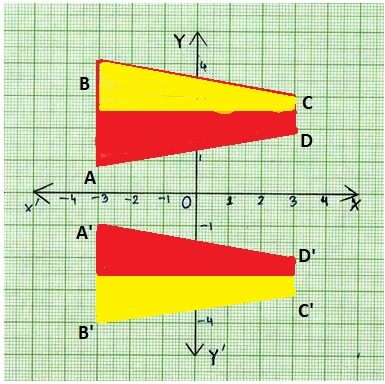
Question 2.
A quadrilateral has a pair of vertical parallel sides on the left and right of the figure. Ryan turns the quadrilateral one-half turn clockwise. Where are the parallel lines on the turned figure?
Answer:
Answer:
A quadrilateral has a pair of vertical parallel sides on the left and right of the figure as shown below, the quadrilateral one-half turn clockwise.

the parallel lines in blue color on the turned figure and are parallel as above.
Question 3.
Does each pair of shapes show a flip, slide, or turn? If so, identify which.
A.

Answer:
Yes,
Explanation:
A flip or Reflection is a motion in which an object is turned over a straight line to form a mirror image.
Every point of an object and the corresponding point on the image are equidistant from the flip line.
Hence, flip is also called a reflection.
B.

Answer:
No,
Explanation:
Every point of an object and the corresponding point on the image are not equidistant from the flip line.
Question 4.
Attend to Precision Complete the drawing of the shape slid to the right.

Answer:

Explanation:
The given figure is pentagon which is a mirror image.
A flip or Reflection is a motion in which an object is turned over a straight line to form a mirror image.
Every point of an object and the corresponding point on the image are equidistant from the flip line.
Hence, flip is also called a reflection.
Question 5.
STEM A biologist is studying leaves with line symmetry. Complete the biologist’s sketch of the leaf by flipping the shape across the vertical line.

Answer:

Explanation:
A flip or Reflection is a motion in which an object is turned over a straight line to form a mirror image.
Every point of an object and the corresponding point on the image are equidistant from the flip line.
Hence, flip is also called a reflection.
Question 6.
Attend to Precision Complete the drawing of the shape after it has been turned.

Answer:

Explanation:
A rotation is a transformation that turns a figure about a point.
Which means the circular movement of an object around a center.
It is possible to rotate different shapes by an angle around the center point.
Test Prep
Use the information for Problems 1-3.
Daniel is babysitting his little sister. He makes her a sandwich and then uses a cookie cutter to cut the sandwich into the shape of a rhombus. Then he flips the sandwich over.
Question 7.
What shape is the flipped sandwich?
Answer:
Rhombus,
Explanation:
Rhombus is a quadrilateral with all equal sides.
Since opposite sides of a parallelogram are equal.
Question 8.
Determine the number of pairs of parallel sides for the flipped sandwich. ___ pairs of parallel sides
Answer:
Two pairs of parallel sides.
Explanation:
Every rhombus has two diagonals connecting pairs of opposite vertices,
and two pairs of parallel sides.
Question 9.
Are the side lengths of the flipped sandwich longer, shorter, or the same size as the side lengths of the un- flipped sandwich?
Answer:
Yes, same size.
Explanation:
The sides of flipped sandwich has the same size as the side lengths of the un- flipped sandwich.
Question 10.
Select the description of the transformation of the given figure.
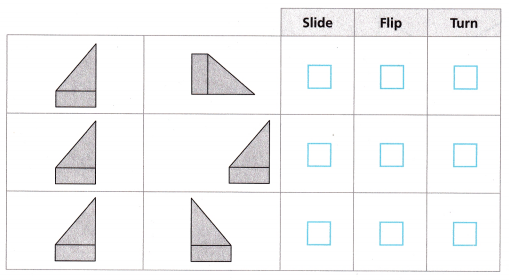
Answer:

Explanation:
When we observe the above picture,
First row picture is turned right side.
Second row picture is slides with some space.
Third row picture is flipped.
Spiral Review
Question 11.
A store sells a bicycle tube for $21.00 and a tire patch kit for $9.00. The tax rate is 7%. How much would it cost to purchase both?
Answer:
$32.10
Explanation:
A store sells a bicycle tube for $21.00 and a tire patch kit for $9.00.
$21.00 + $9.00 = $30.00
The tax rate is 7%.
30 x \(\frac{7}{100}\)
= \(\frac{210}{100}\)
= 2.1
Total cost to purchase both = $30.00 + $2.1 = $32.10
Question 12.
Find the area of a circle with a radius of 6 centimeters. Use 3.14 for π.
Answer:
113.04 cm
Explanation:
Area of circle = πr2
radius = 6cm; π = 3.14
A = 3.14 x 6 x 6
A = 113.04 cm
Question 13.
Arlo rolls a standard number cube three times. What is the chance the number cube will land on an even number all three times?
Answer:
\(\frac{1}{8}\)0.125 or 12.5%
Explanation:
Probability is about estimating or calculating how likely or ‘probable’ something is to happen.
number of even numbers in a cube = 2 , 4 , 6 = 3 numbers
total numbers = 1 , 2 , 3 , 4 , 5 , 6 = 6 numbers
probability of landing an even number once,
= \(\frac{3}{6}\) = \(\frac{1}{2}\)
probability of landing even number thrice,
= \(\frac{1}{2}\) x \(\frac{1}{2}\) x \(\frac{1}{2}\)
= \(\frac{1}{8}\)
= 0.125
= \(\frac{1}{8}\) x 100 = 12.5%